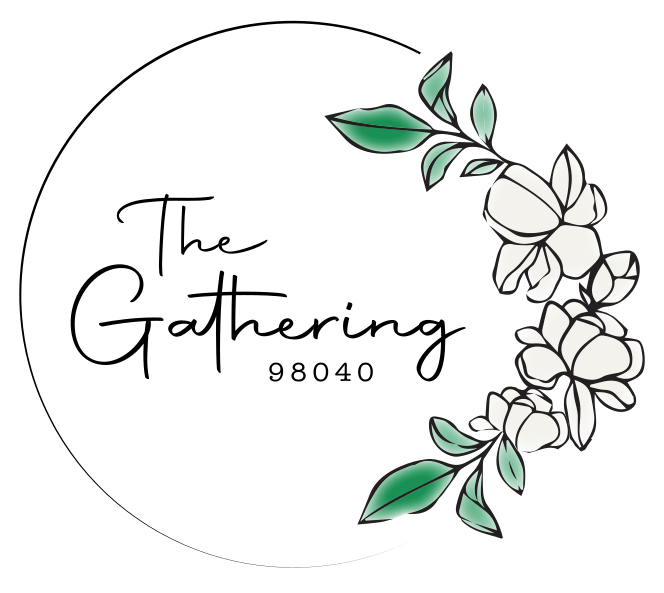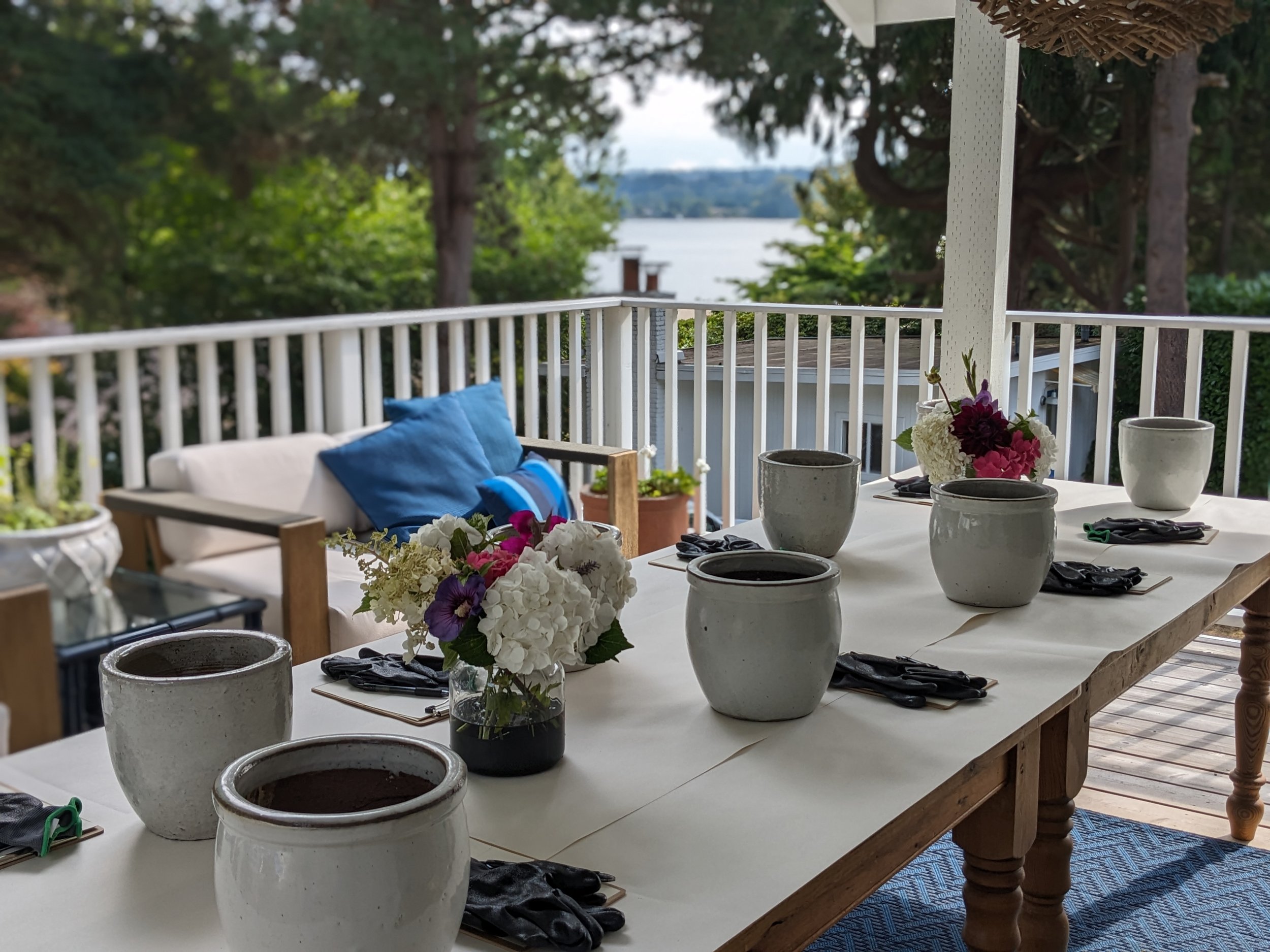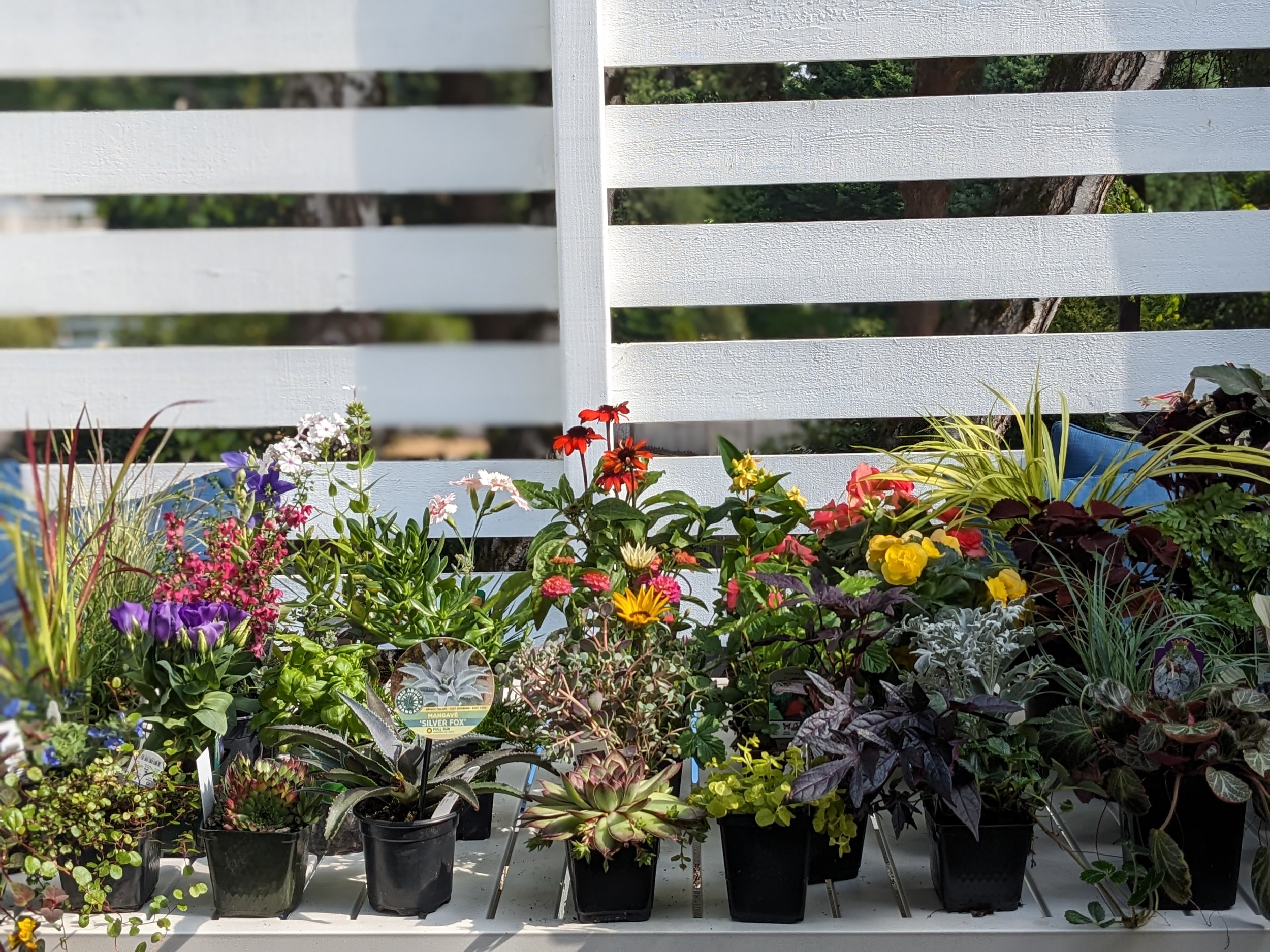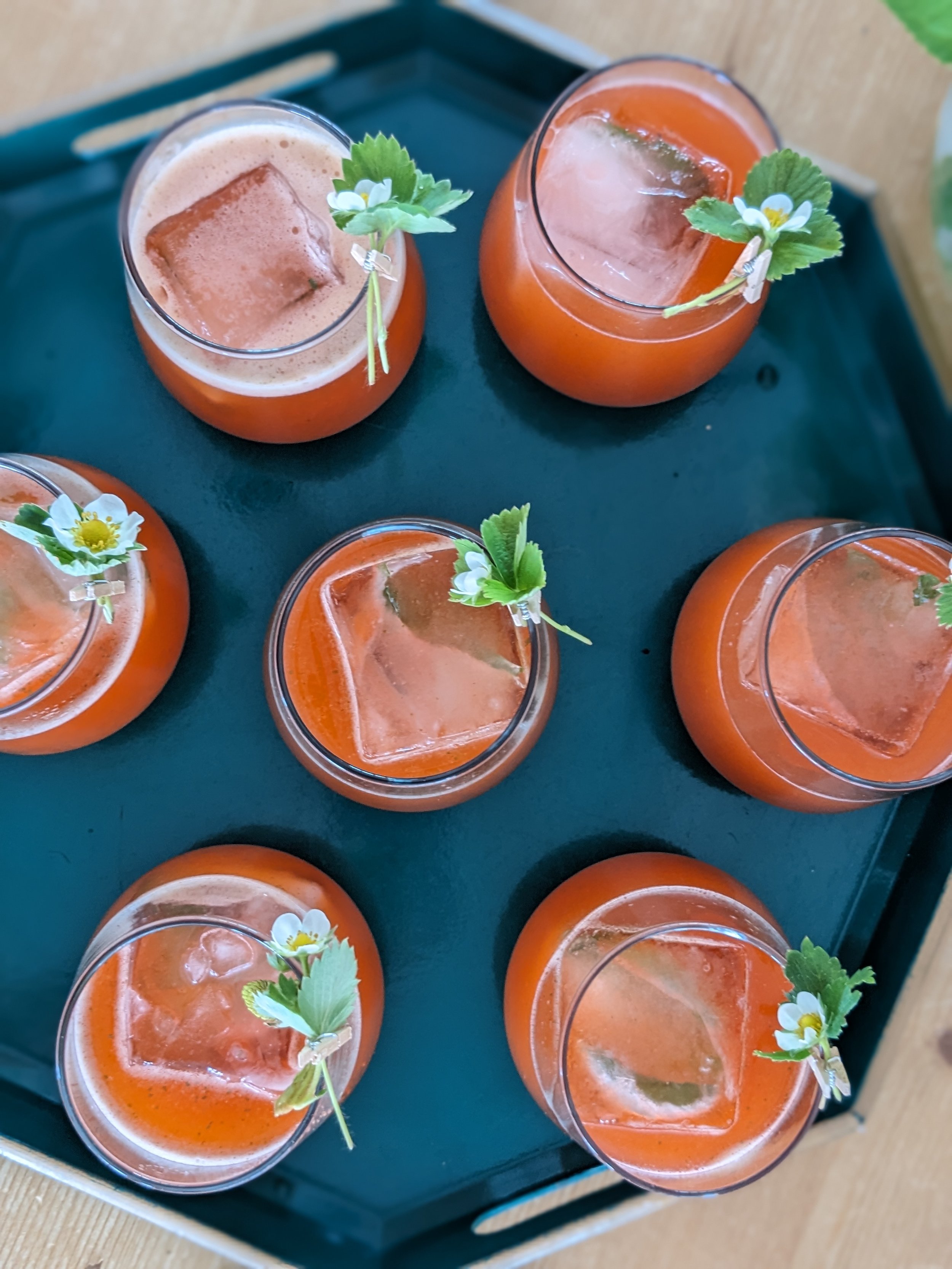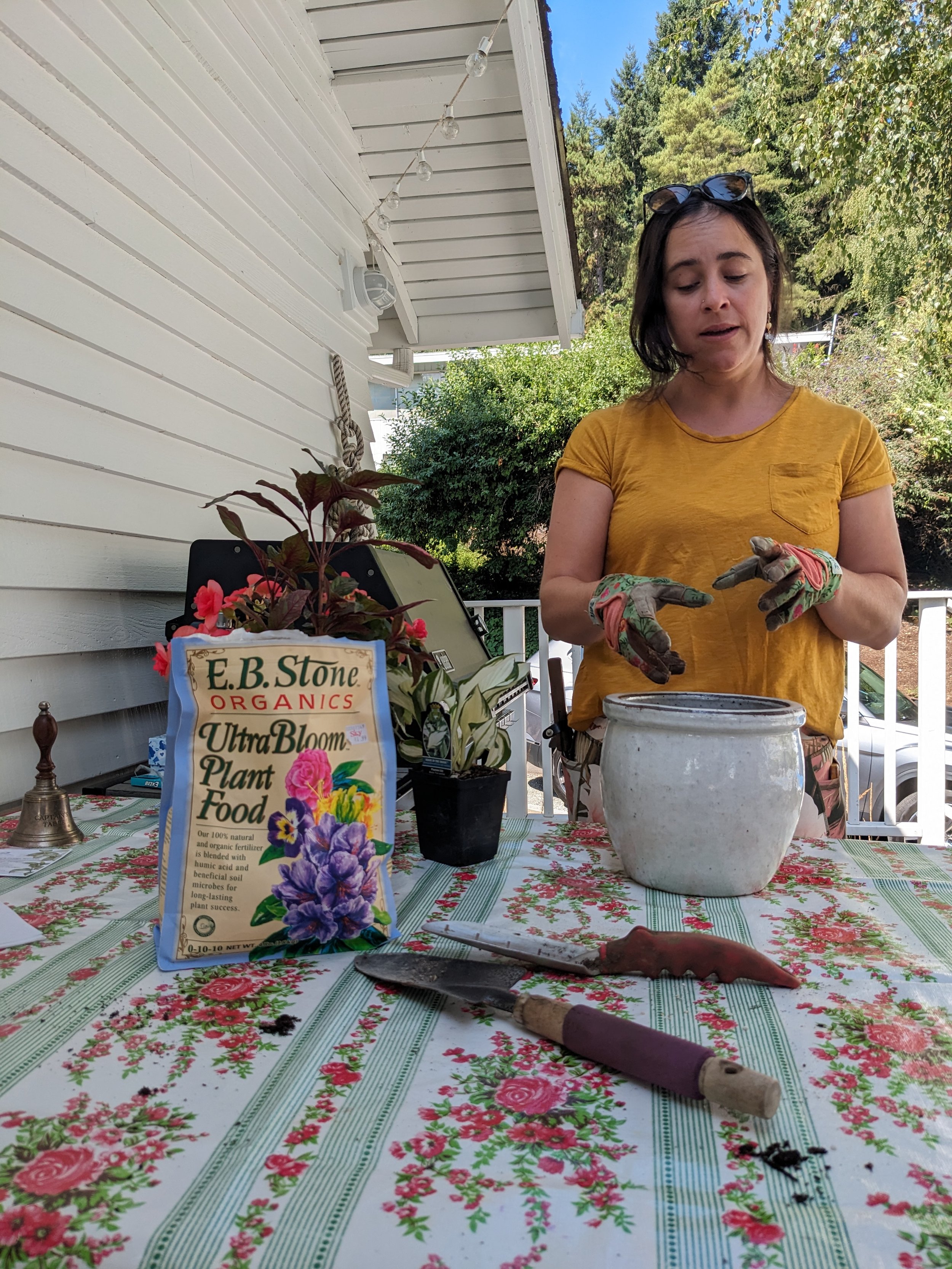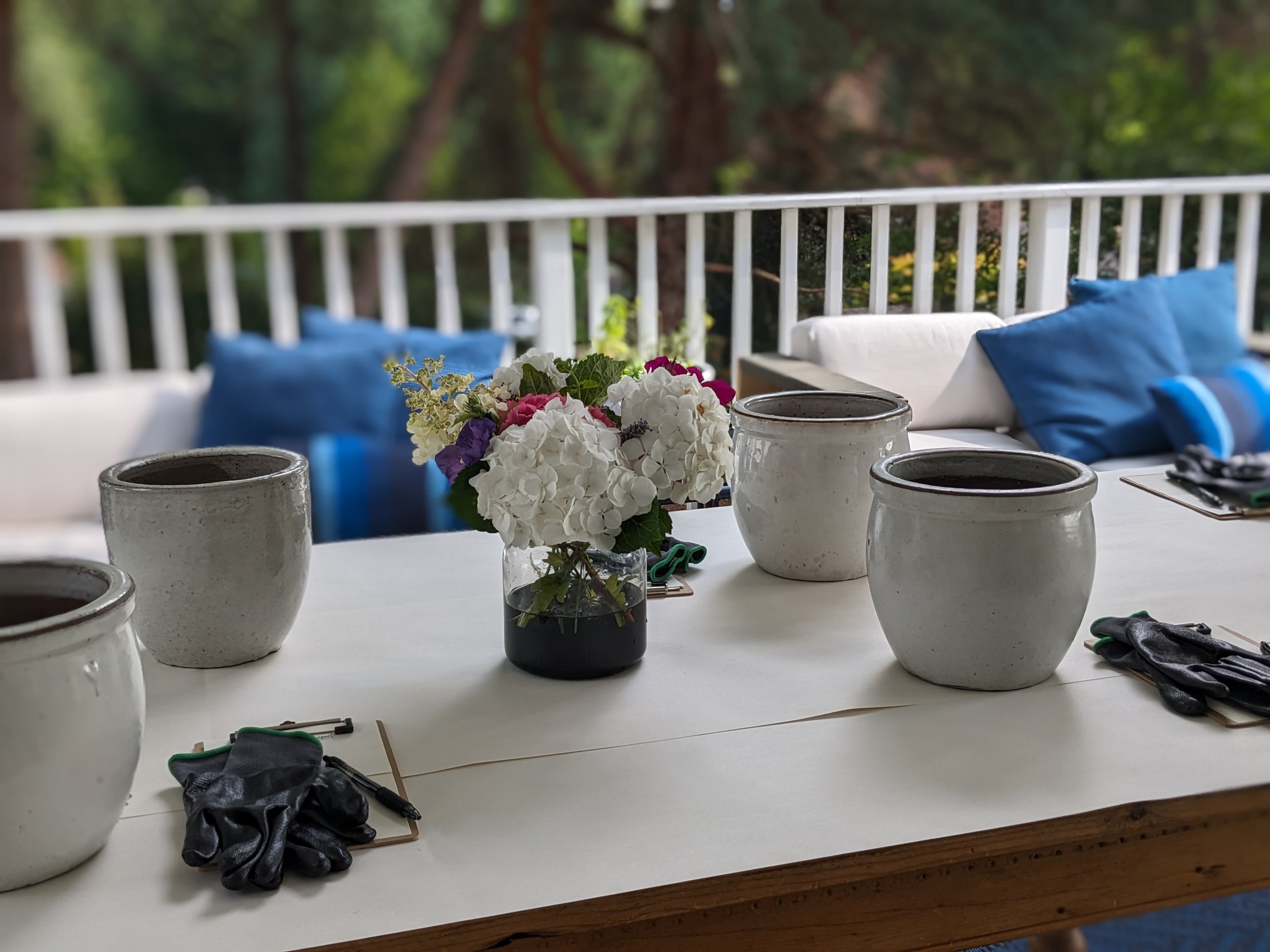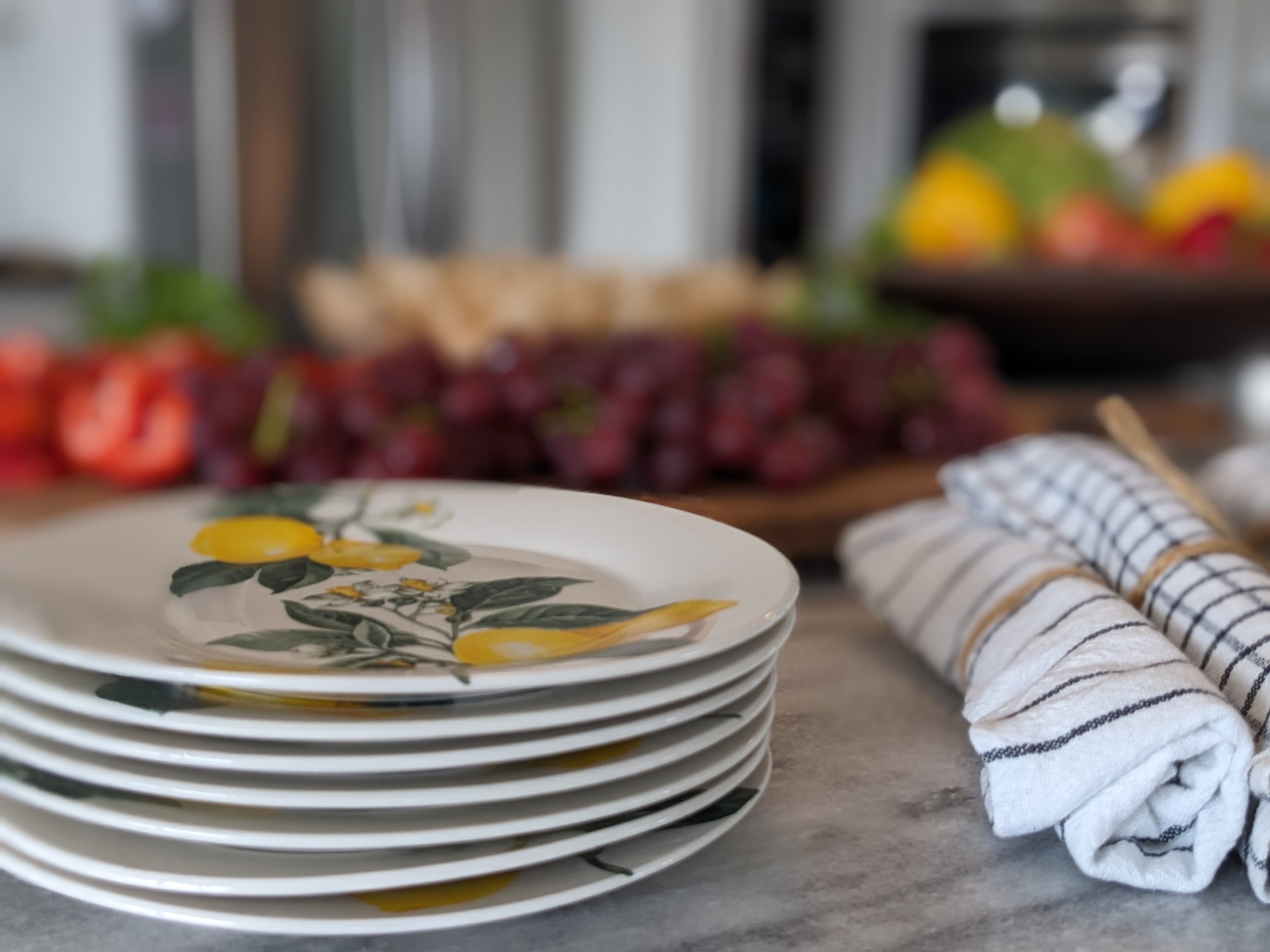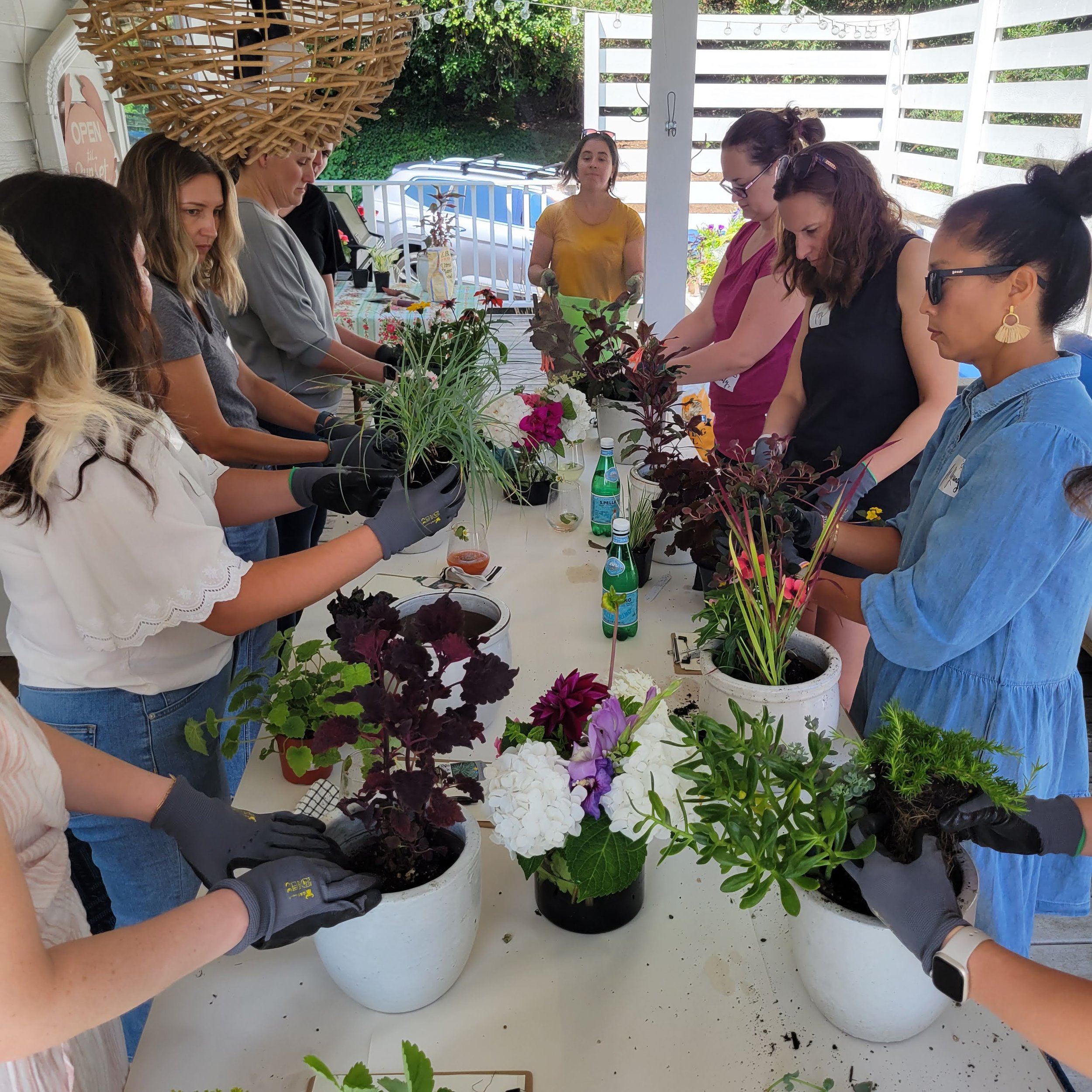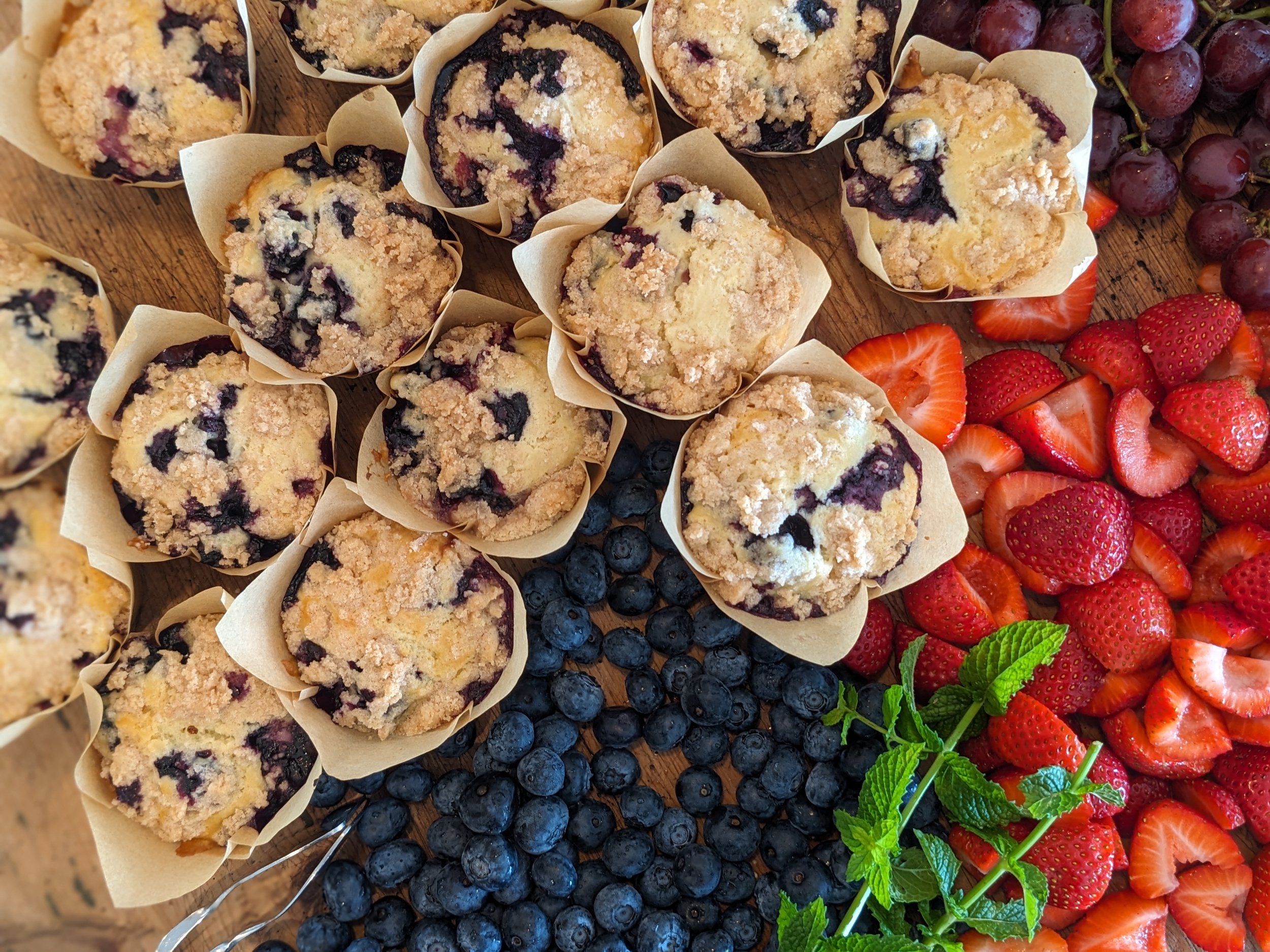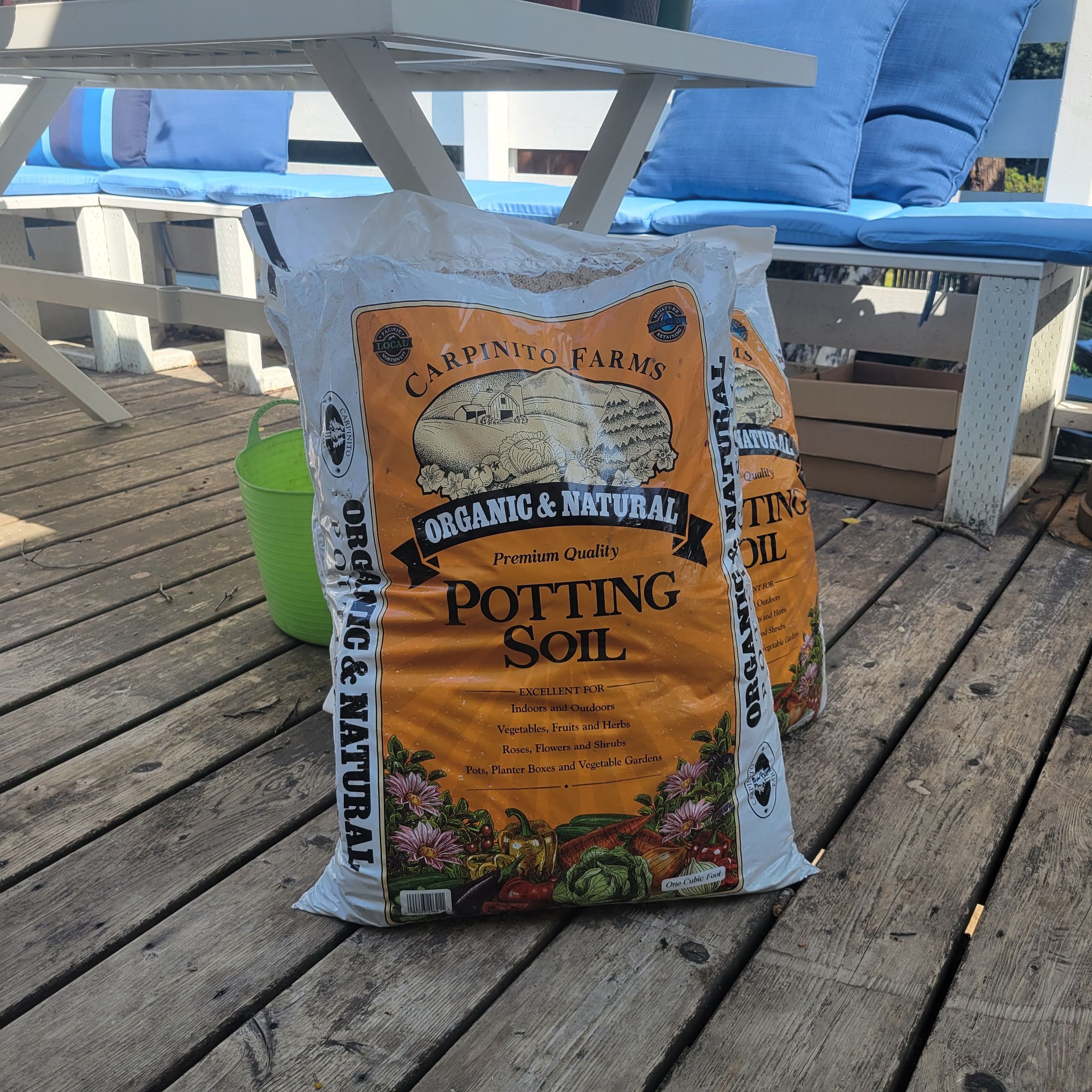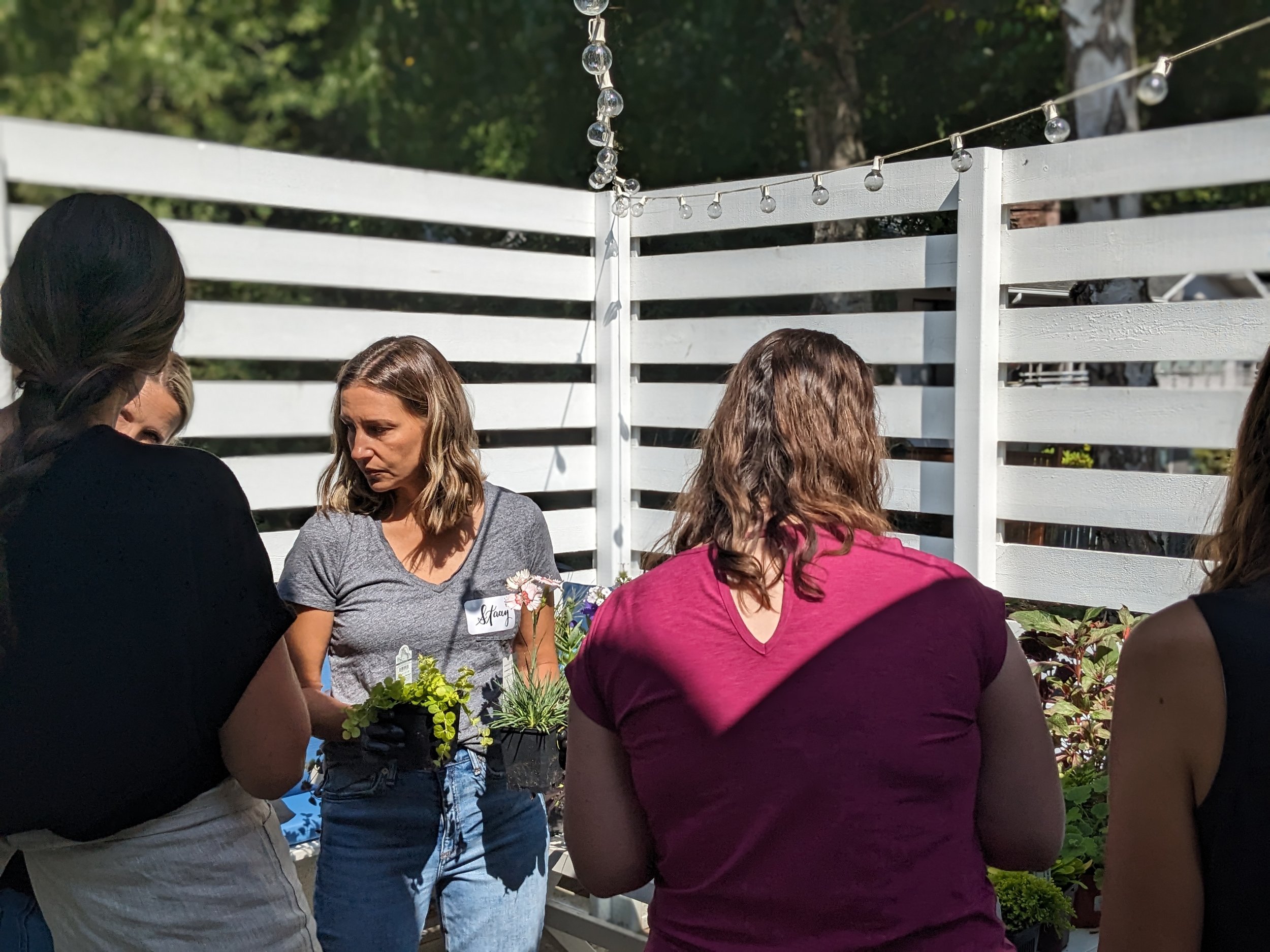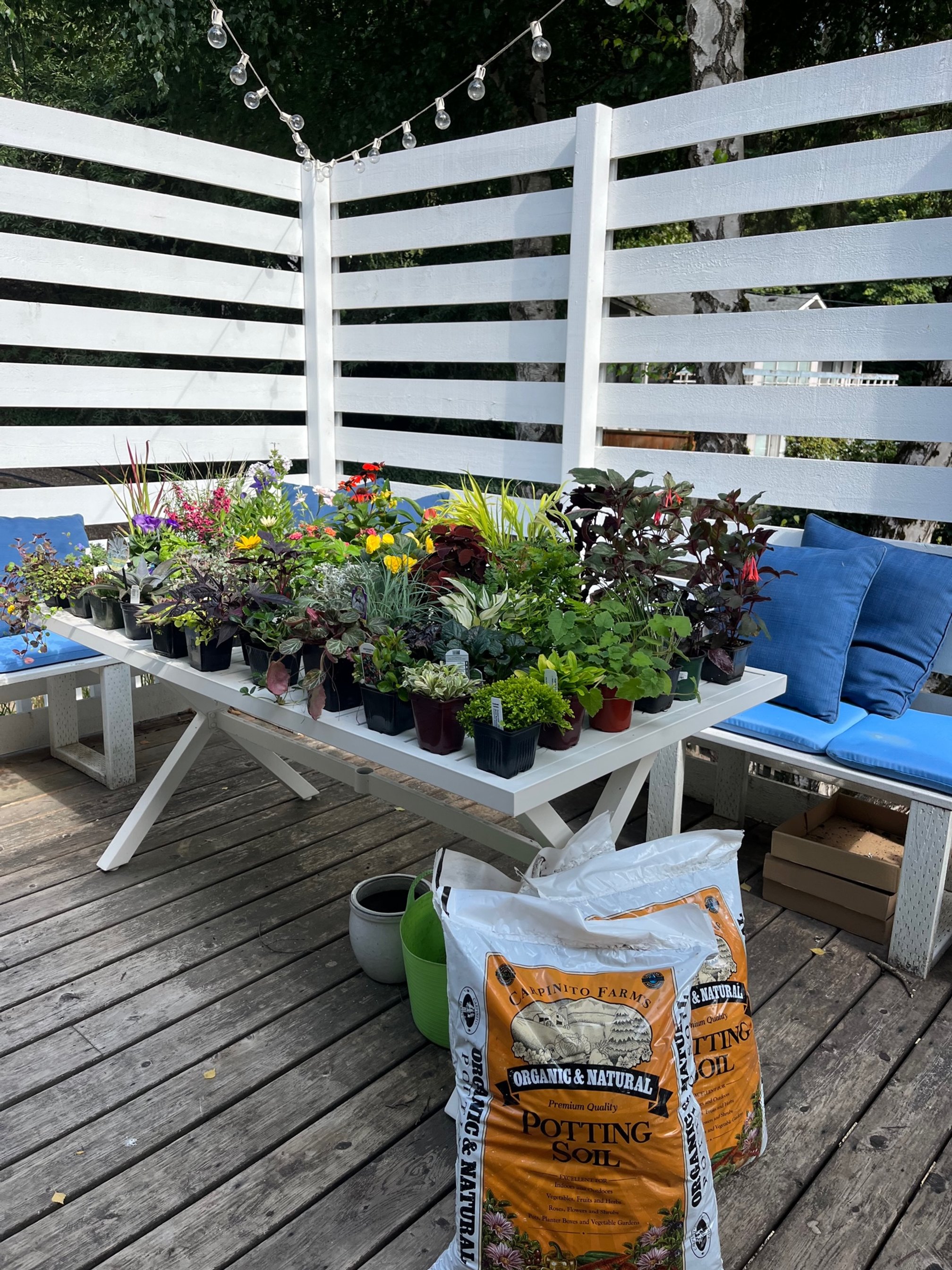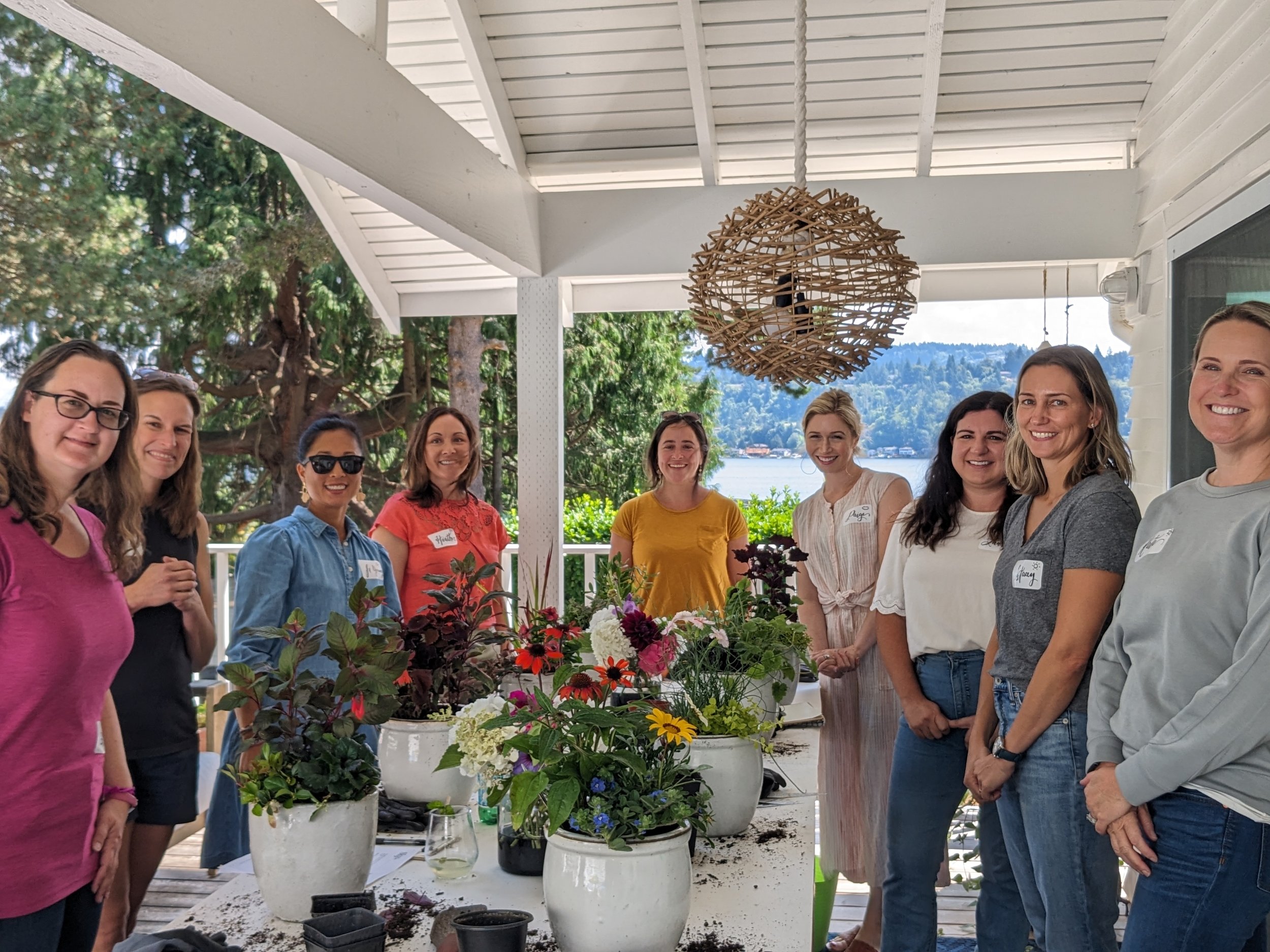Summer Container Gardening: Learn to style your planters like a pro
We had a lovely time creating colorful summer garden planters this past Sunday morning with Juliana Bertucci of The Nonesuch LLC. Read on for tips, tricks and useful products that will help you beautify your own home garden.
We began our morning with a delicious spread of fruit, just-baked blueberry buckles, homemade strawberry basil lemonade and freshly brewed coffee. Following some time for our guests to mingle and nosh on the nibbles we headed out to the patio for the hands-on portion of our gardening workshop.
Juli had setup what could accurately be described as an abundant buffet of beautiful plants and flowers for guest to choose from. Each attendee selected the planter style of their choice and then began to pick out their favorite plants. Throughout the morning Juli offered up helpful tips for gardening both inside and out. She walked attendees through the proper way to fill their containers (don’t press your soil down!), and discussed different ways to plant based on where the pots will be placed (if you will only be viewing your plant from one side place all your plants while viewing the pot from that specific angle).
Prior to the event attendees had decided whether they would be placing their planters in the shade or sun, so once at the workshop they were able to choose plants accordingly. Once plants were selected guests began to create their own garden planter, each bursting with vivid summer colors. It was amazing to see how each pot turned out differently, reflecting the individual style of each person creating it.
Juli’s gardening tips and tricks:
Always combine plant types based on similar sun and water needs.
Your watering plan should be to always do so in the morning, and only at the roots of the plant, not over the leaves. This discourages pests, mold, etc. from latching onto leaves. If your soil becomes too dry, it will be hydrophobic (water-repelling). If you're having trouble with water just running straight out of it, you can place your pot directly into water so that it can absorb up from the bottom.
Always use an "indicator" plant in every container. Choose something that is more sensitive (for example echinacea) that will notify you quickly if it's thirsty and therefore tip you off to caring for your plants before others start to show stress.
Strawberry Basil Lemonade:
Ingredients: 1 cup of fresh lemon juice, 3/4 cup sugar, 4 cups warm water, 8-10 strawberries (tops removed), 1/3 cup fresh basil, 1/2 cup vodka (optional).
Directions: Juice the lemons and transfer the juice into a large pitcher. Add the sugar and the water and stir to combine and dissolve the sugar. Let cool entirely. Add the strawberries and basil. Using an immersion blender, blend the mixture for about 20 seconds just until the mixture turns pink and the basil is finely chopped. Strain out any of the basil bits if you don't want them, they'll have already infused into the drink. Add alcohol if desired. Serve over crushed ice and enjoy!
**We like to add edible flowers or basil leaves to our ice molds for an elevated touch!
Thanks #whatsgabycooking for this delicious recipe!
Sun or shade? We had so many beautiful plants for guest to choose from. We especially loved the Ajuga, October Daphne Stonecrop, Drummond’s Pink Phlox and Creeping Jenny.
Guests making the final tweaks to their planters. They finished up by tucking in a little more soil to get the planters ready for some water. What beauties!
“Think of pots as mini-greenhouses where you can move things in and out of them and feature different types of plants at different times.”
Each workshop attendee went home with their own custom ceramic planter, new garden gloves, a “recipe card” for creating more planters at home, and a wealth of knowledge for keeping their plants healthy, happy and beautiful at home.
-
Look for zone information on plant tags (our area is Zone 8A).
For Zone 7 and higher, those plants are considered annuals based on our location and will not survive the winter.
Plants labeled as zone 7 and lower are more cold-tolerant.
Perennials look dead in the fall, but are actually just going dormant and will come back next year. You can move them out of your planter and into another space in your yard. They are important for our ecosystem even in their winter phase (leaves, seed heads, etc. provide shelter, etc. for songbirds).
-
Always use an "indicator" plant in every container. Choose something that is more sensitive (for example echinacea) that will notify you quickly if it's thirsty and therefore tip you off to caring for your plants before others start to show stress.
Consider what plants are blooming now versus what will bloom later, and be sure to incorporate both.
Fill your planter halfway with soil, then add a scoop of fertilizer over the top.
Leave your soil loose and do not compact it. If you tamp it down, the feeder roots of your plants cannot easily spread; they'll actually feel as if they've hit the wall of the planter.
To remove plants from their plastic containers, squeeze container to loosen, then grasp the crown of the plant with one hand and overturn. Loosen the soil and roots almost with a gentle massage. This gives them room to disperse in their new soil.
Always fill a pot from your point of view, unless it will be seen from all sides, then you would rotate as you go.
Make a pocket in the soil, then place your plant so that the top of its soil is level with where the glaze inside the pot rim ends. Then tuck soil around the edges to fill.
In terms of filling large pots with other organic material to help fill space, filling it entirely with soil will help maintain even temperature throughout your planter.
You will typically change out your containers about twice a year. This is not season dependent, and can be done any time.
When swapping plants out, replace at least half of the soil. If it has been a year or more, replace all soil to replenish nutrients.
-
While no plant is completely deer-proof, some plants are less appealing to deer than others. These plants may have tough, fuzzy, or bad-tasting foliage or bark, which deer tend to avoid. Additionally, deer's tastes can change depending on the season and the availability of other food, so what is unappealing to deer one year may be more appealing the next.
Annuals, Perennials, & Bulbs:
Bears Breech, Yarrow, Ageratum, Columbine, Thrift, Silver Sage, Wormwood, Aster, Astilbe, Begonia, Swan River Daisy, Serbian Bellflower, Perennial Bachelor’s Buttons, Red Valerian, Jupiter’s Beard, Snow-in-Summer, Marguerite, Godetia, Farewell-to-Spring, Tickseed, Crocosmia, Crocus, Hardy Cyclamen, Dahlia, Bleeding Heart, Foxglove, Purple Coneflower, Fleabans, Cranesbill, California Poppy, Spurge, Euryops, Blue Marguerite, Ferns, blanketflower, Gazania, Cranesbill, Hellebore, Strawflower, Daylily, Thyme, Rosemary, Sage, Hyssop, Candytuft, Impatiens, Iris, Corn Lily, Red Hot Poker, Torch Flower, Lavatera, Statice, Lupine, Monkeyflower, Bee Balm, Forget-me-not, Daffodil, Catmint, Poppy, Beard-Tongue, Phlox, Gloriosa Daisy, Black-Eyed Susan, Salvia, Lavender Cotton, Saxifrage, Pincushion Flower, Senecio, Dusty Miller, Blue-Eyed Grass, Lambs’ Ears, Germander, Verbena, Sweet Violet, Calla Lily, Speedwell.
Grasses:
Sedge, Blue Fescue, Lilyturf, Black Mondo Grass, Fountain Grass, Feather Grass.
Groundcovers & Vines:
Ajuga, Kinnikinnik, Ceanothus, Point Reyes Creeper, Cotoneaster, Salal, English Ivy, St. John’s Wort, Lamium, Lithodora, Japanese Spurge, Thyme, Periwinkle, Wisteria.
Shrubs:
Abelia, Bamboo, Berberis, Buddleia, Buxus, Callistemon, Calluna Vulgaris, Ceanothus, Chaenomeles, Choisya Ternata, Cistus, Cotoneaster, Daphne, Eleagnus, Erica, Escallonia, Feijoa, Ilex, Juniperus, Kerria Japonica, Leptospermum, Mahonia, Nandina Domestica, Phormium Tenax, Pyracantha, Rhododendron, Sumac, Flowering Currant, Sweet Box, Snowberry, Lilac, Evergreen Huckleberry, Viburnum.
Trees:
Fir, Vine Maple, Japanese Maple, Silk Tree, Cedar, Redbud, False Cypress, Alaska Cypress, Mediterranean Fan Palm, Hawthorn, Cypress, Eucalyptus, Fig (edible figs), Ash, Gingko, Holly, Magnolia, Pacific Wax Myrtle, Spruce, Pine, Douglas Fir, Oak, Giant Sequoia, Yew.
-
Indoor soil is very different from outdoor soil, so be sure to use accordingly.
Soil labeled indoor/outdoor should be used for outdoors only. Soil clearly labeled only as indoor should be used inside. Indoor soil is sterile and therefore free of worms, and other additions that you would not want in your home. (Juli's soil suggestion is an indoor product made by Espoma)
Juli recommends compost from Cedar Grove, as she likes that they're a local compost pick up service that converts our waste into something beneficial.
-
Felco makes fantastic hand shears/pruners.
Genuine leather gloves are the best for Roses, brambles, or any prickly business. A weeding sickle or triangle garden hoe are also excellent hand tools.
Juli’s favorite tool by far is the Hori Hori, a traditional Japanese gardening knife. She has the simple Nisaku brand but here is a link describing some other options:
Juli Bertucci’s Favorite Garden Supply Vendors
Juli always recommends nurseries over big box stores like Home Depot or Fred Meyer. The plants are of higher quality, the customer service is more responsive, and they are more likely to use sustainable practices (and fewer harmful chemicals).
Sky Nursery: Has a practical selection of plants and tools in addition to their bulk landscape products like mulch. Their products are very reasonably priced. Sky Nursery
Molbaks: Molbaks often has unique and hard to find house plants and perennials. They also have a cafè with delicious bites and a huge home decor section. Molbaks is a very fun place to visit. Molbaks
Pottery Land: Juli’s favorite place to shop for ceramics; nice selection but not too overwhelming. Pottery Land
Our top picks for gardening
Now that you’re ready to style your planters like a pro it’s time to get the necessary tools. We’ve rounded up some of our team’s favorite gardening products. We’ve only listed items that we’ve tried and love. We hope you love them too!
Plant Food: We swear by this houseplant food that will keep your indoor plants thriving. The starter kit comes with a beautiful amber dropper bottle which makes it easy to add to your water can on Water Wednesday. The bottle is pretty enough to leave on the counter, then as you use it, you keep the bottle and only have to purchase refills! Plant Food
Flower Snips: Let these snips do the work for you with their carbon steel blade and soft ergonomic handle. The single-hand lock makes closing them up after use a breeze. Flower Snips
Solar Powered Firefly Lights: These lights are solar powered so you won’t have cords running through your garden. They sway in the wind and create the most lovely glow and ambiance. Firefly Lights
Soil Moisture Meter: This is an essential tool for use with all of our indoor plants. It takes the guesswork out of knowing when to water. Soil Moisture Meter
Floret Seed Sale: Lucky for us, it's exactly time for Floret's highly anticipated August Seed Sale, so get them while they last. Browse their library of highly curated heirloom and uncommon seed varieties to create a show-stopping garden that even your most well-versed gardening friends will stop to ask what that unique item you have growing is. Floret Seed Sale
Floret Farms Cut Flower Garden: Let this book from local Skagit legend Floret Farms serve as equal parts gorgeous coffee table book and inspirational guide to growing and harvesting gorgeous blooms in your home garden. Cut Flower Garden
Bamboo Garden Work Gloves: Good gloves are tricky to find because there still aren’t a lot of great work gloves made for women. These are Juli’s recommended gloves. Garden Work Gloves
Supergoop Play Sunscreen: Don’t forget to protect your skin while you’re working in the garden. We love this sunscreen because it’s light weight and free of harsh chemicals. Supergoop Play Sunscreen
Until we gather again!
**As Amazon Associates we earn from qualifying purchases.
